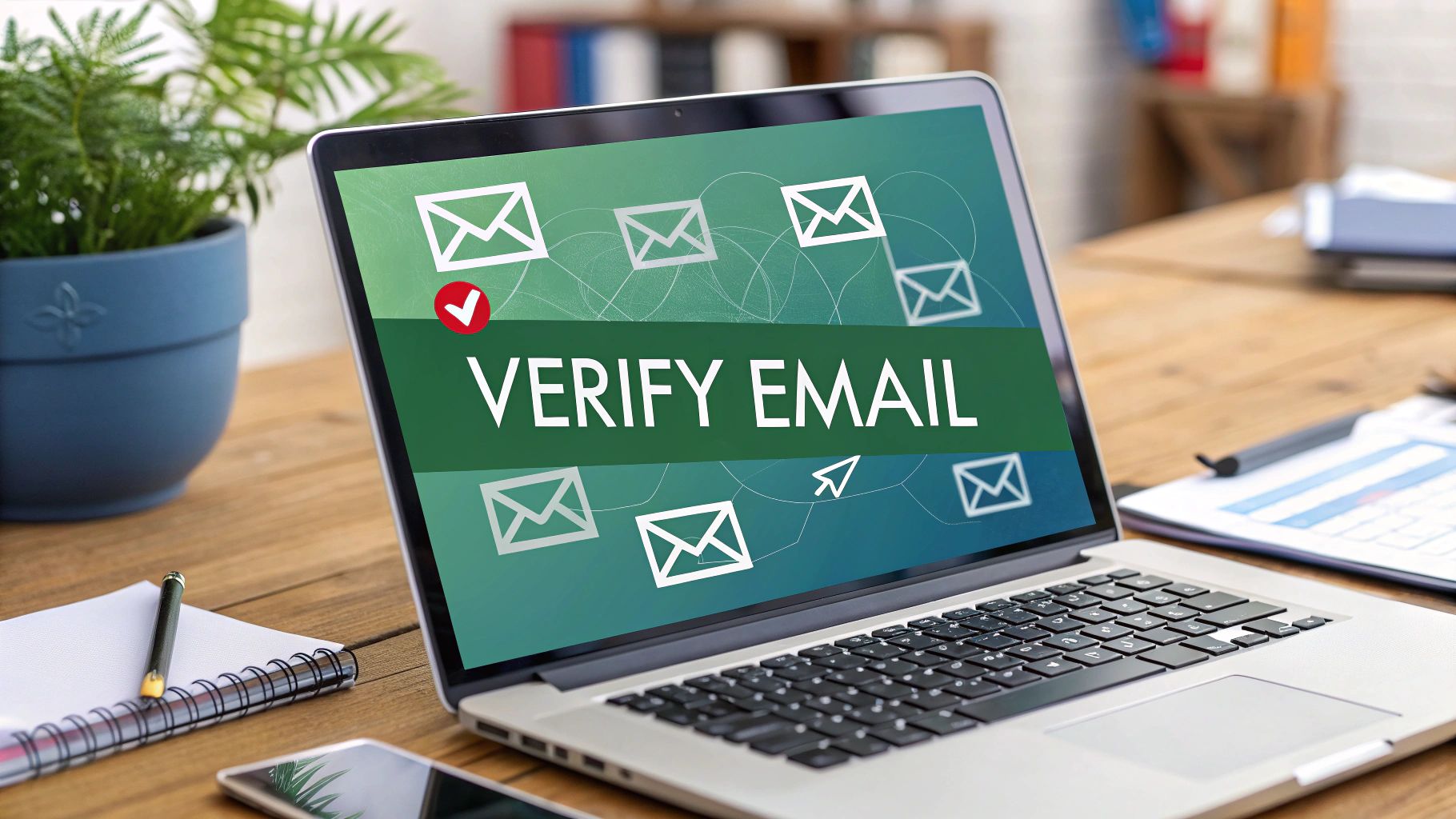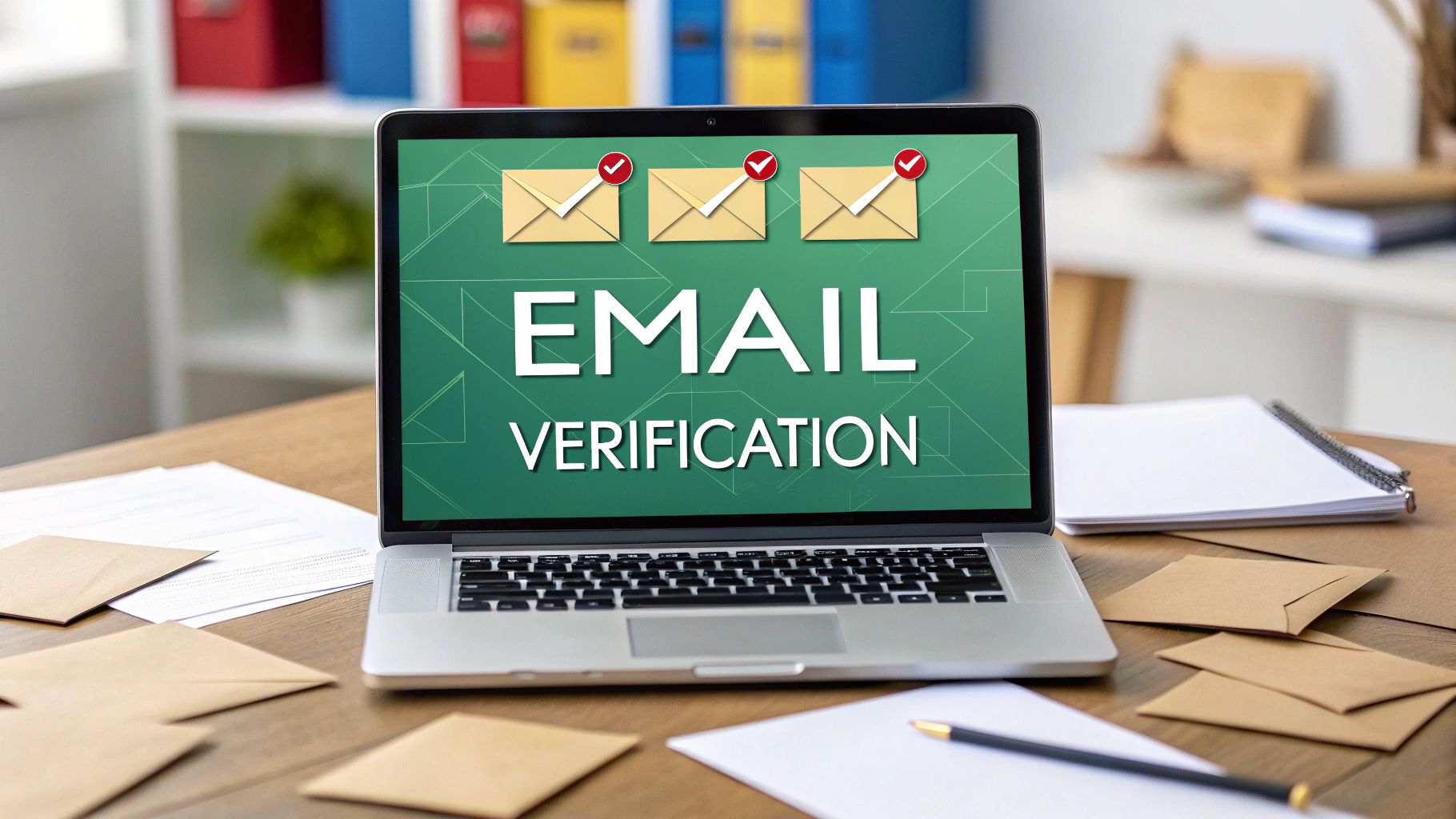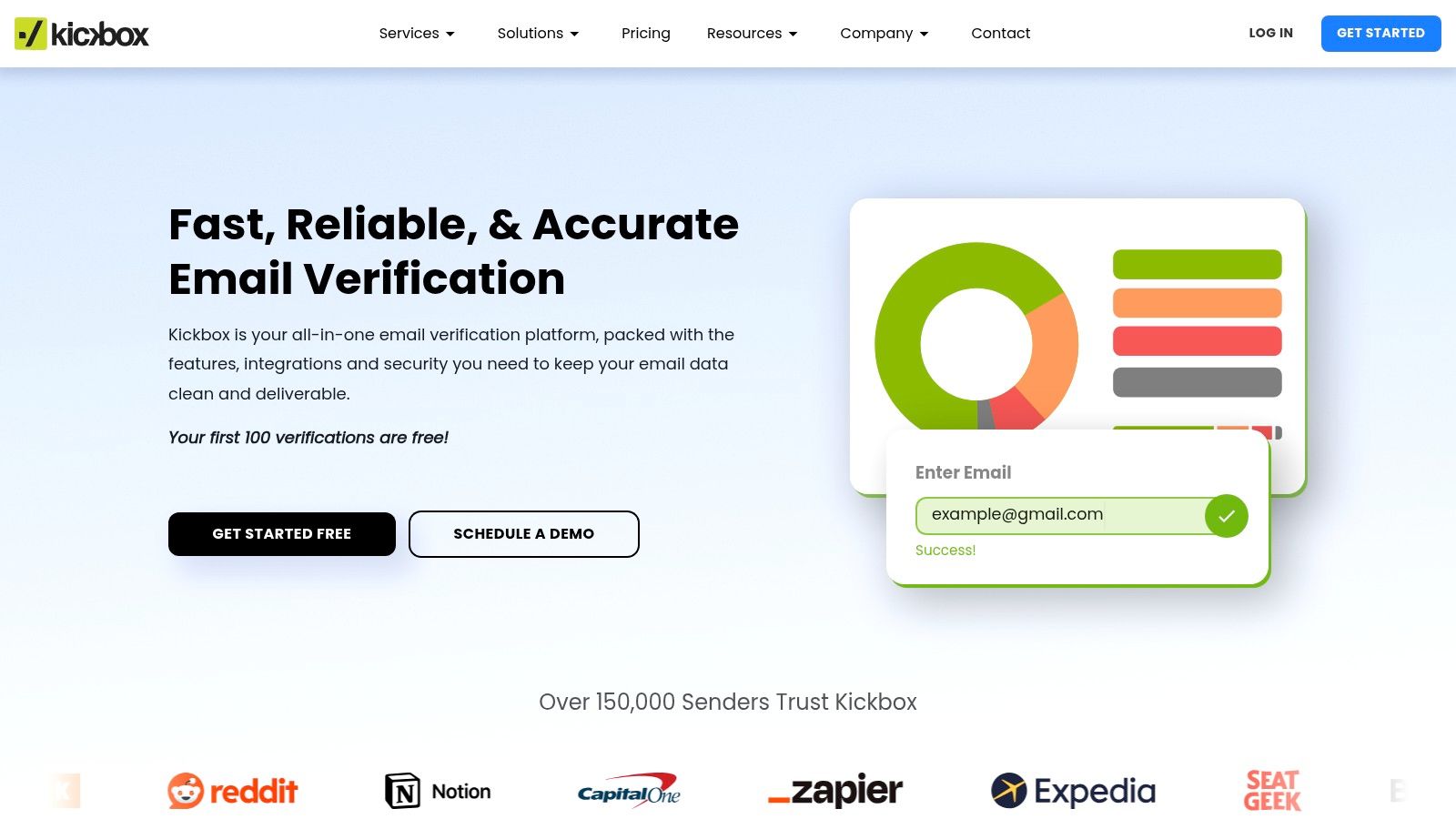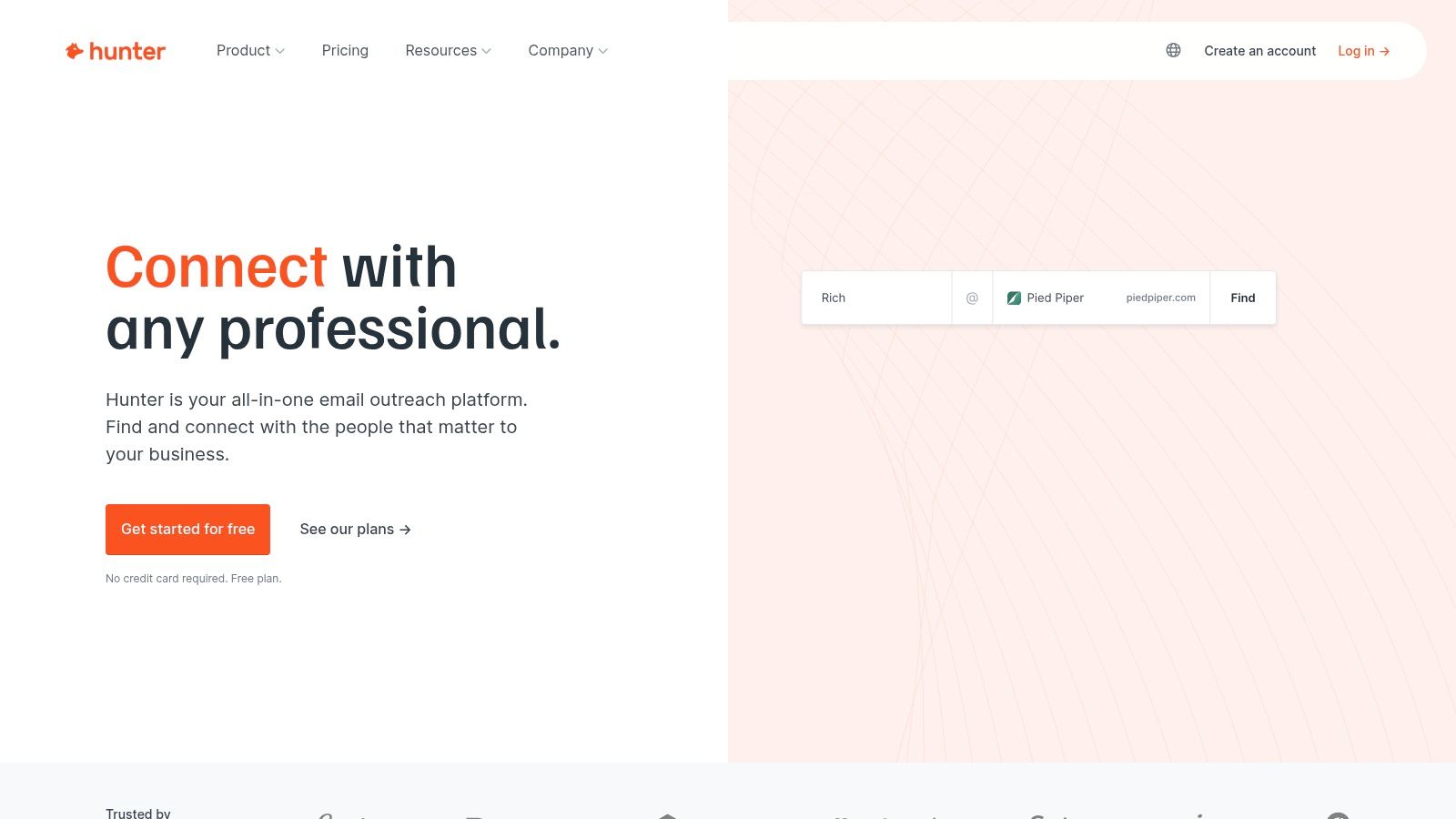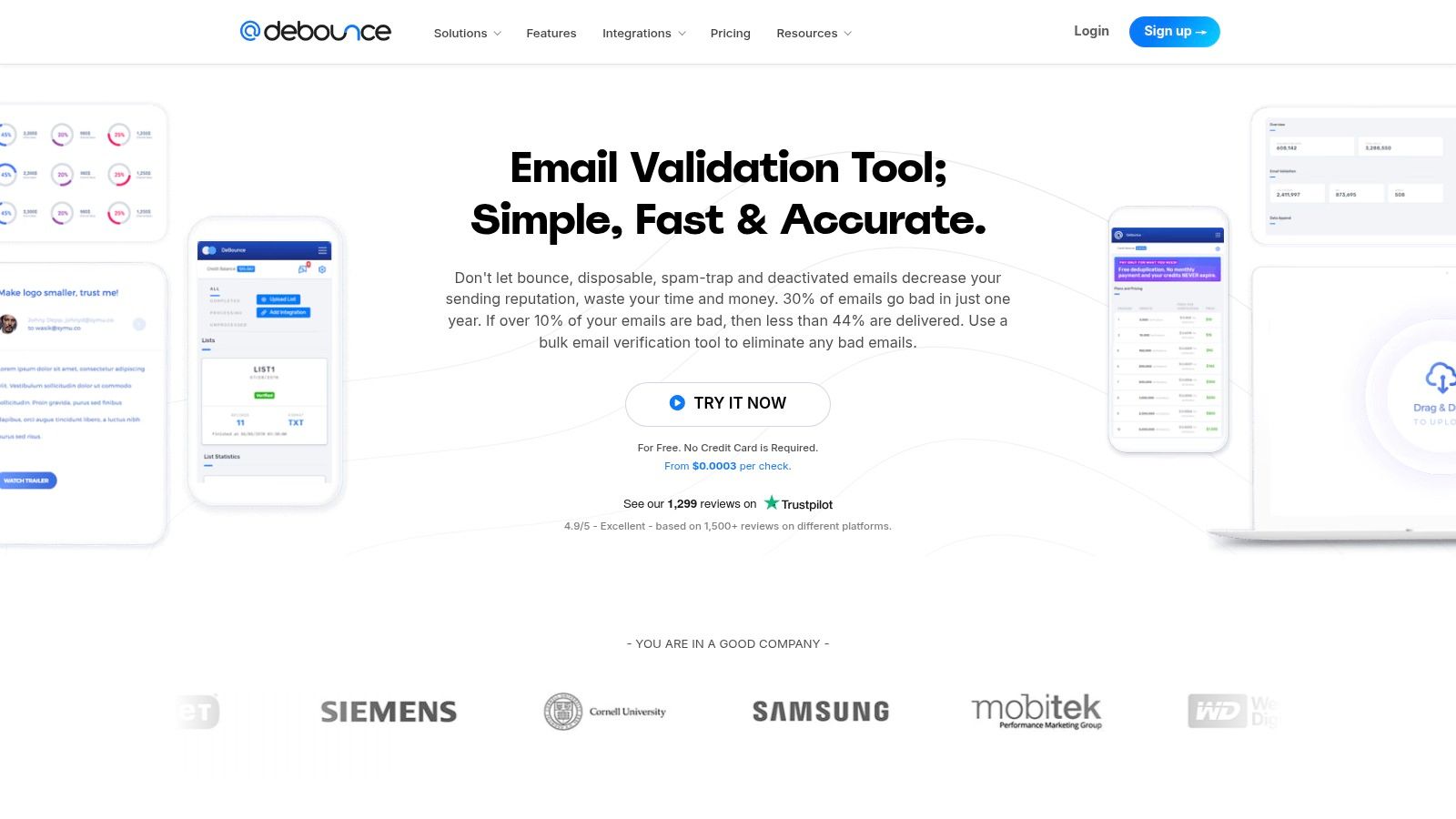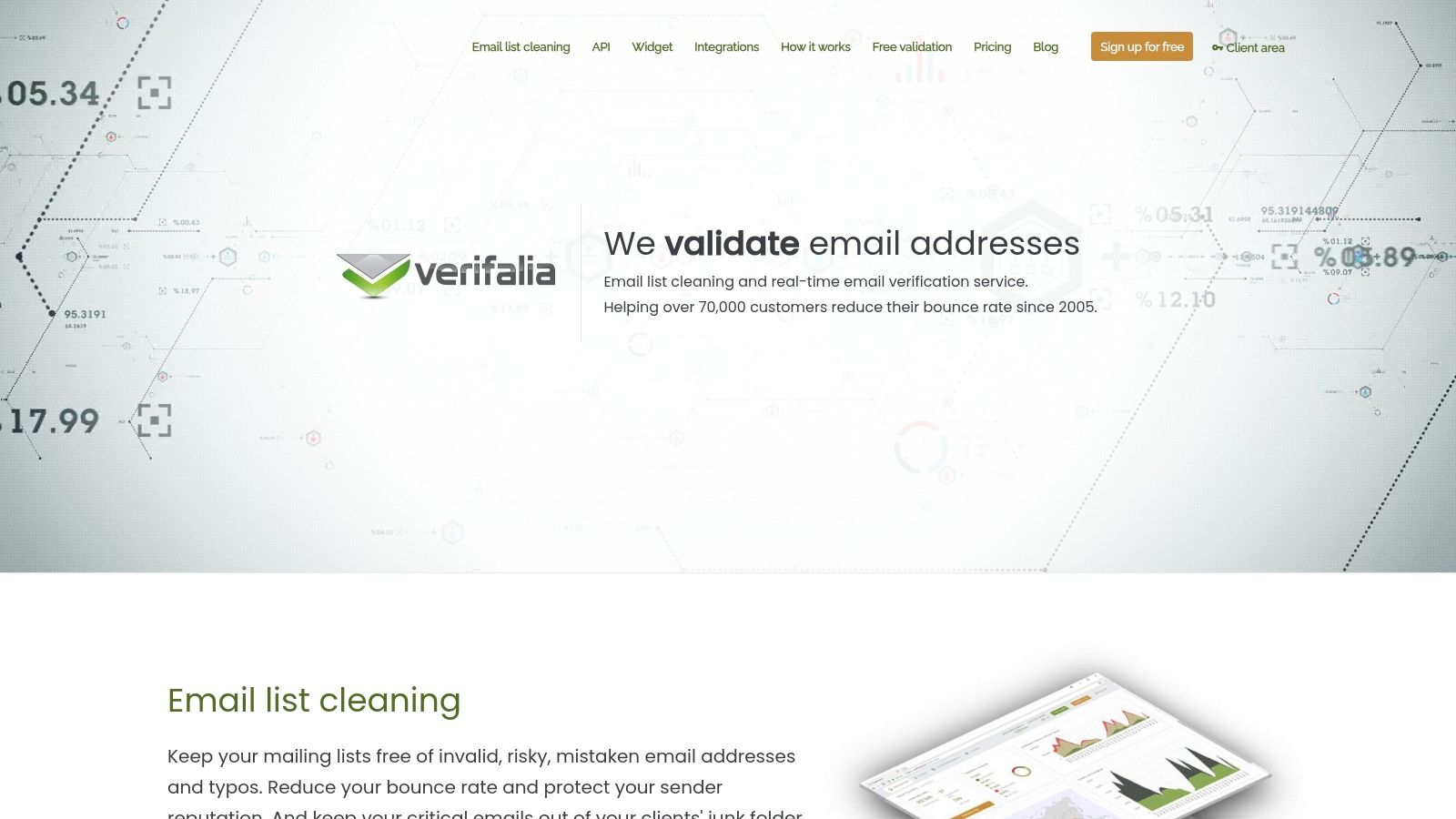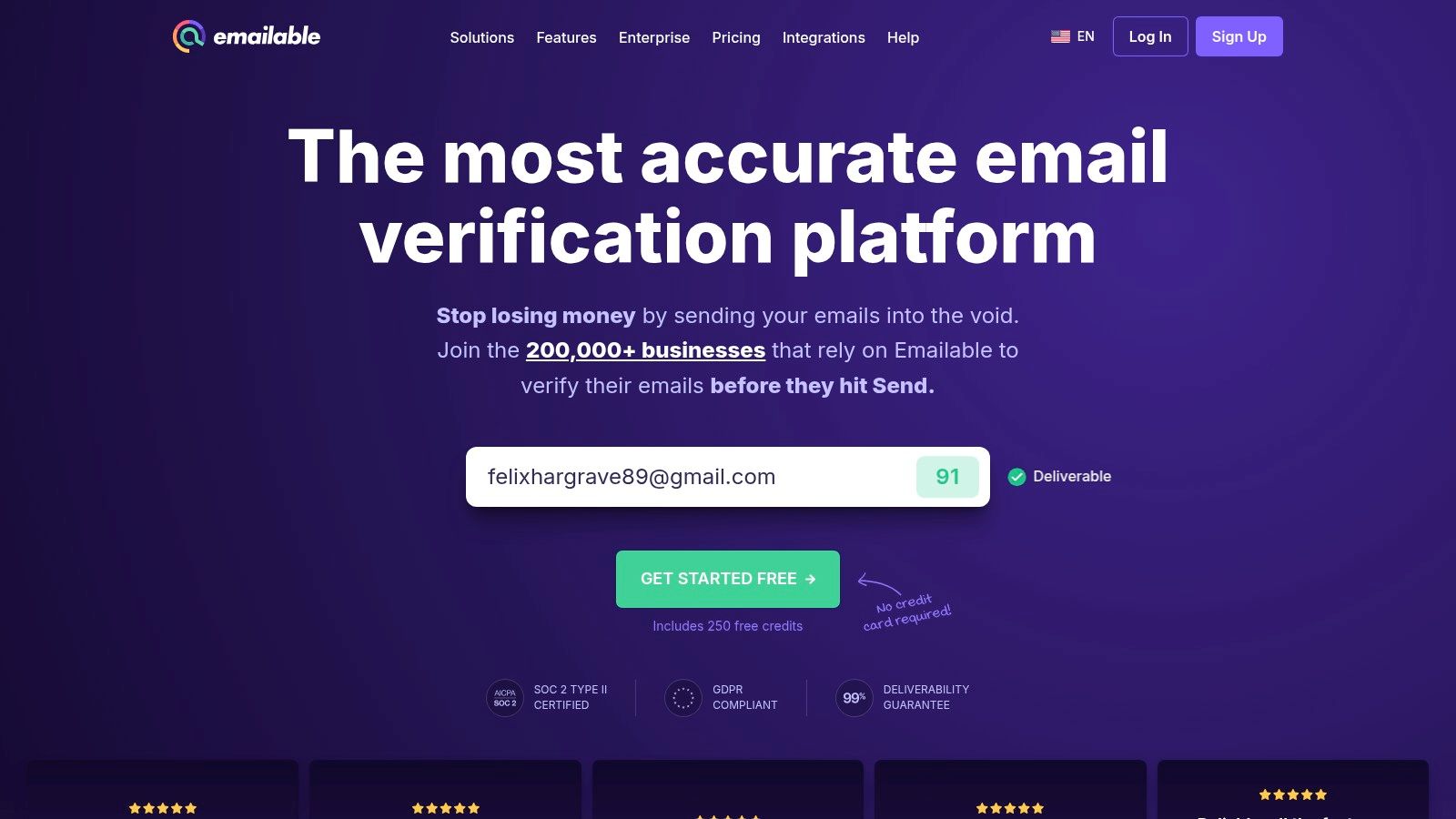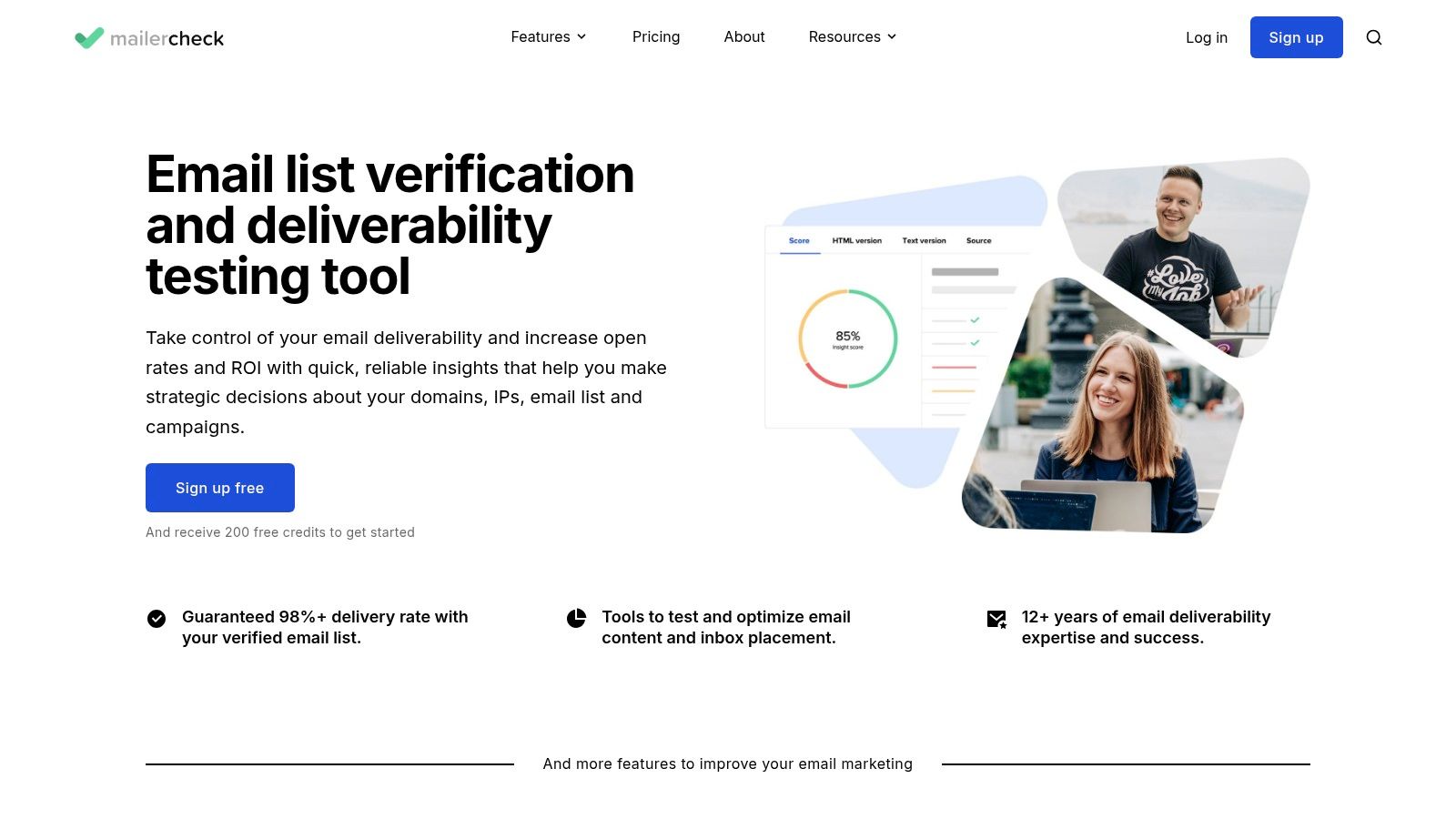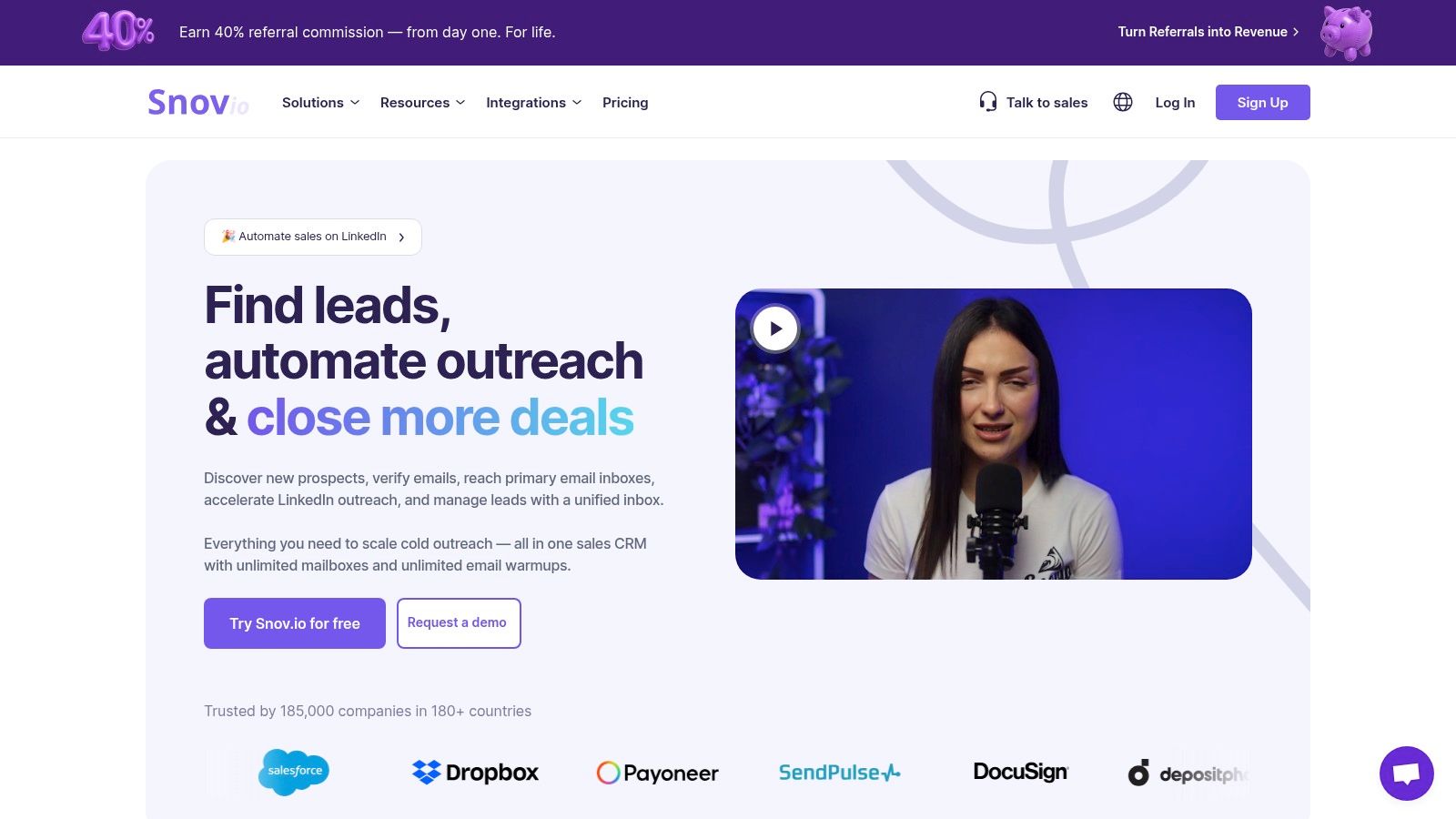To figure out if an email address is any good, you need to run it through a gauntlet of checks. It starts simple, with a basic syntax check, but quickly moves to more serious tests like SMTP verification. This whole process confirms that an email is not only formatted correctly but that its domain can actually receive mail and that a specific inbox is real and waiting.
Why Email Verification Is So Important for Growth
Sending an email seems easy, right? But its success is completely tied to the quality of your contact list. Every time you skip verification, you're taking a direct hit to your marketing budget, your sender reputation, and your overall shot at growth. An unverified list is just a minefield of dead ends—typos, old addresses, and throwaway accounts that only hurt your campaigns.
This isn't just about a few minor hiccups; it's about protecting your brand's reputation. When your bounce rate starts climbing, the big players like Google and Microsoft notice. They start to see you as a potential spammer, which is the fast track to getting your messages filtered, blocked, or worse, having your domain blacklisted entirely.
The Real Cost of a Dirty Email List
The fallout from a poorly maintained list goes way beyond a few bounced emails. Every single "undeliverable" message chips away at your sender score—a critical metric that basically decides if your emails land in the inbox or get tossed into the spam folder. A low score means even your most loyal subscribers might never see your messages.
Think about the ripple effect:
- Wasted Money: You pay your email service provider for every email you send, whether it gets delivered or not. Sending to bad addresses is literally throwing money in the trash.
- Messed-Up Analytics: High bounce rates completely skew your performance metrics. This makes it impossible to know what’s actually working or to make smart, data-driven decisions for your next campaign.
- Trashed Sender Reputation: Internet Service Providers (ISPs) are always watching. If you keep sending emails to mailboxes that don't exist, it signals that you don't care about your list hygiene, which tanks your future deliverability across the board.
A clean email list isn't just a 'nice-to-have'—it's the foundation of any email marketing strategy that actually works. Taking the time to verify your list ensures your message has a fighting chance to be heard, protecting both your investment and your brand.
You can see how modern tools are designed to tackle this problem head-on. The screenshot from EmailScout's homepage shows an interface built for one thing: efficiency. It lets you process and clean your lists fast, so you can avoid the pitfalls of bad data.
What Email Verification Means for Your Business Metrics
Let’s take a look at the real-world impact of keeping your email list clean. The table below shows a clear 'before and after'—the risks you run with an unverified list versus the rewards you get from a clean one.
Impact of Email Verification on Key Marketing Metrics
| Metric | Without Verification (The Risk) | With Verification (The Reward) |
|---|---|---|
| Deliverability Rate | Plummets as bounces and spam complaints rise. | Stays high (98%+), ensuring messages reach the inbox. |
| Bounce Rate | Climbs above 2%, damaging sender reputation. | Remains low (well below 0.7%), signaling a healthy list. |
| Sender Reputation | Degrades quickly, leading to blacklisting. | Strengthens, improving inbox placement with major ISPs. |
| Campaign ROI | Decreases due to wasted sending costs and missed opportunities. | Increases as more emails reach engaged, real customers. |
| Engagement Rates | Skewed and unreliable due to invalid data. | Accurate and actionable, reflecting genuine user interest. |
As you can see, the benefits are immediate and directly tied to performance. All the hard work you put into building your email list deserves to be protected.
If you're already focused on smart tactics like lead magnets and sign-up forms, you need to be just as focused on making sure those addresses are valid. For more on this, check out our detailed guide on how to build an email list.
Ultimately, proactive verification is what fuels the metrics that matter. With over 347 billion emails sent every day and average open rates hovering around 24%, every single send counts. Keeping your bounce rate below the industry benchmark of 0.7% is non-negotiable; go over that, and you're telling email servers you can't be trusted. By making sure your emails reach real people, you create more opportunities for opens, clicks, and sales—turning your list into a reliable engine for growth.
Understanding the Layers of Email Validation

When you want to verify if an email address is valid, it's not a single check. Think of it more like a quality control line in a factory. Each station looks for a different problem, and an email only gets the "valid" stamp after passing every single inspection.
This layered approach is absolutely critical. It systematically weeds out bad emails at different stages, catching everything from obvious typos to much sneakier issues hiding on the server side. If you skip a layer, you’re letting bad data slip through, which will wreck your sender reputation and drain your marketing budget.
The First Filter: Syntax and Formatting Checks
The first and most basic layer is the syntax check. This is your first line of defense, a quick grammar check for the email address format itself. It’s an automated process that spots fundamental mistakes right away.
This initial pass asks a few simple but vital questions:
- Is there exactly one "@" symbol?
- Are there any illegal characters, like spaces or two dots in a row?
- Does it have a local part (before the "@") and a domain part (after the "@")?
- Is the domain part followed by a valid top-level domain (TLD) like ".com" or ".org"?
For instance, an address like john.doe@.com or jane doe@company.com would fail this check instantly. Catching these simple errors is the low-hanging fruit of email validation, stopping the most obvious data entry mistakes from ever making it onto your list.
Domain and MX Record Validation
Once an email passes the syntax check, the next job is to see if its digital "street address" is actually real. This is where we check the domain and its Mail Exchange (MX) records. An MX record is just a public directory that tells the internet which mail servers are set up to receive email for that specific domain.
If there's no valid MX record, an email has nowhere to go. It’s like trying to mail a package to a house that doesn't exist. This check confirms two crucial things:
- Domain Existence: It makes sure "company.com" is a real, registered domain.
- Mail Server Configuration: It verifies that the domain is actually set up to receive mail.
Verifying MX records is a non-negotiable step. A syntactically perfect email like
contact@nonexistentdomain123.comis still completely useless if the domain itself isn’t configured to handle mail. This check filters out addresses linked to expired or misspelled domains.
These two foundational checks—syntax and domain validation—work together to knock out a huge chunk of invalid emails. They lay the essential groundwork for more advanced methods, like SMTP verification. By understanding how these layers work, you can see just how thorough you need to be to truly verify if an email address is valid and give your messages the best shot at landing in a real inbox.
Using SMTP Checks for Ultimate Accuracy
After you've weeded out the obvious errors with syntax and domain checks, it's time to bring out the big guns: the SMTP check. This is the most definitive test you can run to verify if an email address is valid.
Think of it like a digital "knock on the door." Your verification tool opens a direct line to the recipient's mail server, but it hangs up before actually sending anything.
This quick conversation, often called an SMTP handshake, is incredibly revealing. It essentially asks the server, "Hey, do you have an inbox for jane.doe@company.com?" The server's response is a straight yes or no. All of this happens without a single email ever being sent, which is why it's the gold standard for accuracy.
How the SMTP Handshake Works
The SMTP check is designed to catch the sneaky problems that other methods miss. A classic example is a correctly formatted email for an employee who no longer works at a company.
An address like john.smith@company.com might look perfect. It would sail through syntax and MX record checks. But the SMTP handshake would get a firm "user unknown" response from the server, instantly telling you it's a dead end.
It’s a discreet but highly effective way to confirm an inbox is active and ready to receive your messages. It simulates the first few steps of an email delivery, then stops just short.
This infographic breaks down the foundational checks that pave the way for an SMTP test, showing how each layer builds on the last.
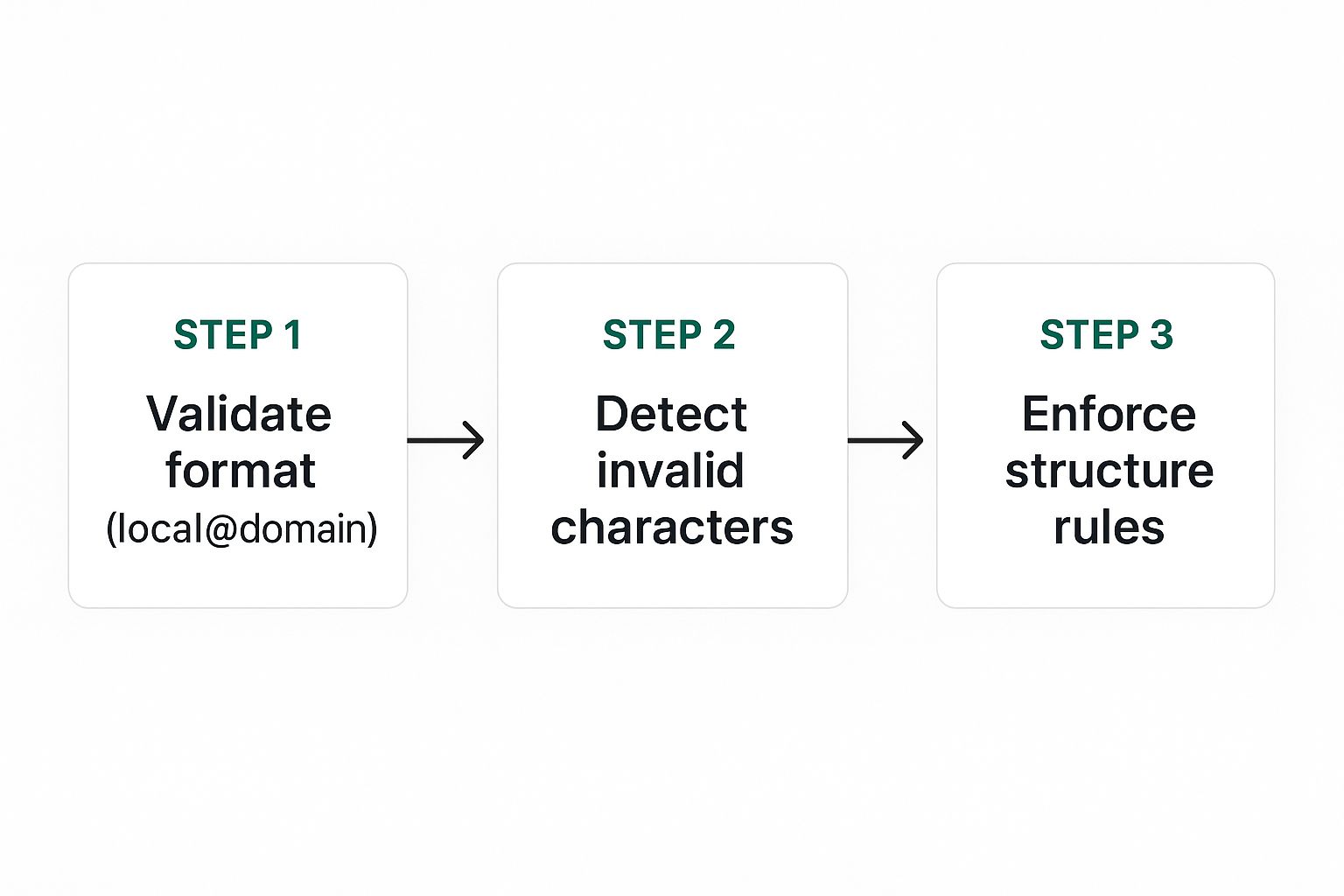
As you can see, an email has to pass the basic structural tests before a more advanced SMTP verification even makes sense.
Navigating Tricky Server Responses
Things aren't always so black and white, though. Some mail servers are set up with a "catch-all" (or "accept-all") configuration. This means the server is programmed to accept email for any address at that domain, even gibberish like asdfghjkl@company.com.
A catch-all server will give a positive response to an SMTP check for any username you throw at it. This makes it impossible to know if a specific inbox actually exists.
This is where a smart tool like EmailScout really shines. It helps interpret these ambiguous server responses for you:
- Valid: The server confirmed the specific user inbox exists. Green light.
- Invalid: The server confirmed the specific user inbox does not exist. Dead end.
- Risky / Catch-All: The server accepts all emails, so we can't be sure about this specific inbox. Proceed with caution.
A "catch-all" status doesn't mean the email is bad—it just means the server is playing its cards close to its chest. For a high-value lead, it might be worth the risk of sending, but just know it could bounce.
Understanding these nuances is what separates amateurs from pros. If you're blasting out a massive marketing campaign, you’ll probably want to skip the "Risky" addresses to protect your sender reputation. But for a handful of targeted sales emails? The potential reward of reaching the right person might easily outweigh the small risk. It's all about making strategic choices to keep your list clean while still chasing down important opportunities.
How to Automate Verification with Modern Tools

Knowing the theory behind email verification is great, but trying to do it all by hand is a whole different story. Let's be real: attempting to verify if an email address is valid one by one is just not feasible for any list that's big enough to matter.
That's exactly where automated tools like EmailScout come into play. They transform what would be a monumental chore into a quick, almost effortless process.
The workflow is refreshingly simple. You typically start by uploading your entire contact list, usually as a straightforward CSV file, right into the platform. From there, the service does all the heavy lifting. It runs every single address through that multi-layered validation gauntlet we talked about, from basic syntax checks all the way to advanced SMTP handshakes.
Within minutes, you get back a detailed report that neatly segments your list into clear, actionable categories. No more guesswork.
Making Sense of the Results
The real magic of these tools isn't just the verification itself—it's how they translate the raw data. Instead of cryptic server codes, you get plain-English statuses that tell you exactly what to do next. This clarity is everything when it comes to protecting your sender reputation and getting the most out of your campaigns.
Most verification tools use a similar set of statuses. Here's what you need to know:
Understanding EmailScout Verification Results
Interpreting the output from your verification tool is the final, crucial step. This table breaks down the common status codes, what they mean for your list, and the best course of action for each.
| Verification Status | What It Means | Recommended Action |
|---|---|---|
| Valid | The email address is confirmed to exist and the mailbox is active. | Green light! Send your campaigns to these contacts with confidence. |
| Invalid | The email address definitively does not exist or was rejected by the server. | Remove immediately. Sending to these will cause a hard bounce. |
| Risky / Catch-All | The server is set up to accept all mail, so the specific inbox can't be confirmed. | Proceed with caution. These have a higher chance of bouncing or being a spam trap. |
| Unknown | The server didn't respond or timed out during the verification check. | It's best to treat these like "Risky" emails. Set them aside for now. |
By segmenting your list based on these results, you can finally make smart, data-driven decisions.
For a massive marketing blast, sticking to just the 'Valid' group is your safest bet. But for a highly targeted sales email? Sending to a 'Risky' address could be a calculated gamble that pays off.
A Look Ahead at Verification Tech
And this space is only getting smarter. Industry experts predict that by 2025, automated email verification systems will routinely use AI to not just validate an address, but to predict its likelihood of being engaged. These next-gen systems go beyond simple pings and checks by analyzing behavioral patterns and historical data to spot potential problems before they even happen.
Ultimately, automation is the only practical path forward for managing email list hygiene at any kind of scale. While there are plenty of services out there, finding one that clicks with your workflow is key.
If you're just dipping your toes in the water, a great place to start is by exploring the 12 best free email verification tools. It's the perfect entry point for building a cleaner, more powerful contact list from day one.
Making Email Verification Part of Your Daily Grind
Good email hygiene isn't something you do once a year. It's a constant, ongoing process that you bake right into your day-to-day operations. The real goal is to shift from reactive cleanups to proactive, always-on maintenance. This ensures your marketing and sales efforts are always built on a solid foundation of real, deliverable email addresses.
This means looking beyond the occasional scrub of your master list. The real wins come when you embed verification at every single point where you collect an email. The most effective way to do this? A real-time verification API on all your signup forms, lead magnets, and checkout pages.
Think of it as an instant gatekeeper. When someone types in their email, the API does a lightning-fast check behind the scenes. If it's a dud—whether from a simple typo or a bogus domain—it gets rejected on the spot. Bad data never even gets a chance to pollute your system.
Creating a Routine for List Maintenance
Even with real-time checks in place, you still need to do periodic list scrubs. It's just a fact of life: people change jobs, companies merge, and old email addresses get abandoned. Data decay is a real thing, with marketing databases losing around 22.5% of their accuracy every single year.
To fight back, set up a simple, repeatable schedule for cleaning your entire database. For most businesses, a quarterly deep clean is the perfect rhythm.
- The Quarterly Scrub: Once a quarter, export your entire contact list and run it through a bulk verification service. This is your chance to catch any addresses that have gone stale since they were first added.
- The Pre-Campaign Check: Got a major campaign coming up? Before you hit send, run that specific segment through one last verification. It’s a crucial final step to boost deliverability and protect your sender score when it matters most.
Proactive verification is a mindset. When you build these checks into your daily and quarterly workflows, you stop treating data hygiene as a chore and start seeing it for what it is: a core part of your growth strategy.
Automating How You Find and Clean New Contacts
Your workflow also needs to cover how you source new leads. When you're building lists from professional networks or company websites, you need a smart way to find and validate contacts at the same time. This is where a couple of good tools can really make a difference.
For instance, after you’ve found some promising leads, you can use a free email extractor online to quickly pull any publicly listed addresses from their websites. But here’s the critical part: you immediately run those new emails through a verification tool before they ever touch your CRM.
This simple two-step process—extract, then verify—makes sure every new contact you add is both relevant and reachable from day one. By making this your standard procedure, you consistently verify if an email address is valid as a natural part of your outreach, not as a separate, annoying task you have to deal with later.
Common Questions About Email Verification

Even when you have a solid game plan, a few questions always seem to pop up once you start digging into email verification. Let's clear the air and tackle the most common ones I hear.
Getting these details right is about more than just cleaning a list. It's about making sure your process is effective, compliant, and built to last.
Is Verifying Emails Legal?
Yes, it's not only legal—it's a marketing best practice. Verifying an email address is a technical process of checking public records and communicating with mail servers. It doesn’t involve snooping on private information or sending a single unsolicited message.
In fact, verification helps you stay on the right side of regulations like the CAN-SPAM Act. This law mandates that you handle opt-outs correctly and maintain a clean list. The penalties for non-compliance are no joke, with potential fines reaching up to $53,088 for a single email violation.
How Often Should I Clean My Email List?
This depends on how fast your list is growing, but a good rule of thumb for most businesses is to do a thorough cleaning at least once a quarter. Email data goes stale faster than you'd think. Some studies show that lists lose over 22% of their accuracy every year as people switch jobs, change providers, or just abandon old inboxes.
If you're a high-volume sender or adding new subscribers daily, moving to a monthly verification schedule is an even smarter move. The real secret is consistency.
Don't wait for your bounce rate to shoot through the roof before you act. Think of regular verification as preventative maintenance for your most valuable marketing channel. It’s a proactive habit that protects your sender reputation and keeps your deliverability sky-high.
Can I Verify a Single Email Address?
Absolutely. While bulk verification is your go-to for cleaning entire databases, there are plenty of times when you just need to check one high-value contact before hitting "send." Nearly every quality verification service has a tool for single email checks.
This is a lifesaver for people like:
- Sales Reps: Double-checking a key prospect's email before sending that crucial first pitch.
- Account Managers: Making sure an important client update actually reaches the right person.
- Recruiters: Validating a top candidate’s contact info before an offer goes out.
It’s a small, quick step that prevents embarrassing bounces on communications that really matter.
Will Verification Hurt My Sender Reputation?
This is one of the biggest myths out there. When done correctly, email verification will not harm your sender reputation. The methods we've discussed, like the SMTP handshake, are designed to be non-intrusive. They open a conversation with the mail server but hang up before actually trying to send an email.
The server just sees a quick, harmless query. What really tanks your reputation is repeatedly sending emails to bad addresses and racking up hard bounces. In that light, verification isn't the problem—it's the solution.
Ready to stop guessing and start connecting? EmailScout gives you the tools to clean your lists, find fresh leads, and make sure your message lands in the right inbox, every time. Try our email finder and verification tools for free and see what a difference a clean list makes.
